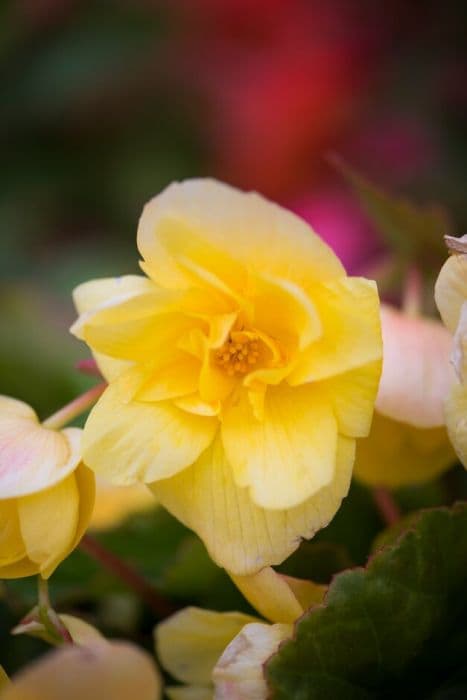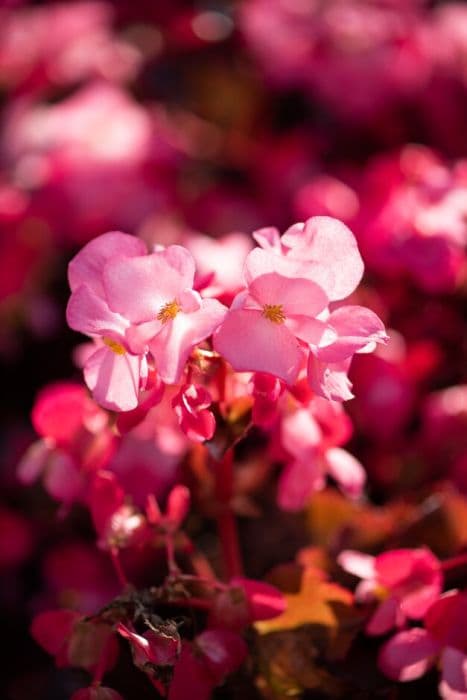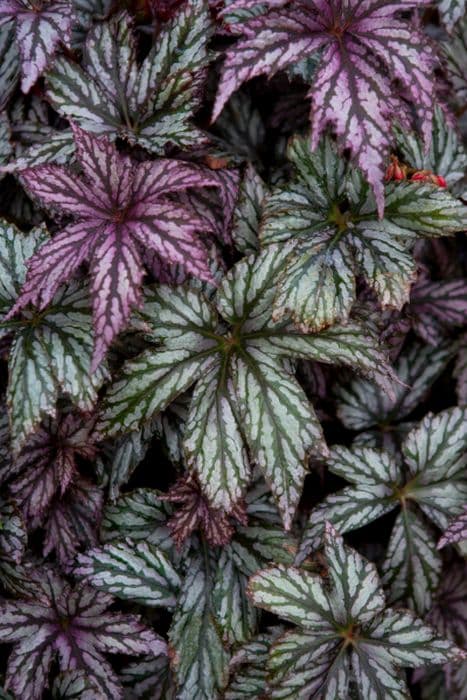Begonia Begonia 'Namur' (R)

ABOUT
The plant known as Begonia 'Namur' features a lush and vibrant appearance with a showcase of captivating foliage and blossoms. The leaves boast a distinct hue with shades that can range from deep greens to bronze tones, often with a metallic shimmer or red undersides that add to its ornamental appeal. The leaf shape tends to be asymmetrical with one side larger than the other, exhibiting a characteristic ear-like shape and an attractive edge that can be toothed or serrated. Adorning the foliage are the begonia’s flowers, which come in clusters that provide a striking contrast against the leafy backdrop. The flowers are delicate with a soft texture, typically in shades of pink, white, or red, forming a gentle palette that complements the leafy coloration. They can have single or double petal arrangements, sometimes displaying a rose-like appearance that contributes to their charm. The Begonia 'Namur' is a versatile plant, often used in containers, hanging baskets, or as bedding plants due to its compact and mounding growth habit. This makes it a valuable addition to gardens and indoor spaces, where its radiant, showy character can be most appreciated. The overall plant conveys a sense of lushness and floriferous beauty, making it a favorite among garden enthusiasts and those who admire ornamental plants.
About this plant
 Names
NamesFamily
Begoniaceae
Synonyms
Namur Begonia
Common names
Begonia 'Namur' (R).
 Toxicity
ToxicityTo humans
Begonias, including the Begonia 'Namur', can contain oxalic acid and other irritating compounds which, when ingested, could cause symptoms such as irritation of the mouth and throat, nausea, vomiting, and difficulty swallowing. The ingestion of large quantities may also lead to kidney stones or other issues due to the presence of oxalates. The severity of the symptoms can vary based on the amount ingested and the sensitivity of the individual.
To pets
Begonias, such as the Begonia 'Namur', are known to be toxic to pets due to the presence of insoluble oxalates. If a pet consumes parts of this plant, it might exhibit symptoms like oral irritation, pawing at the mouth, excessive drooling, vomiting, and difficulty swallowing. In more severe cases, ingestion can lead to kidney failure and other serious health issues. It is important to prevent pets from ingesting any part of the plant to avoid these potential consequences.
 Characteristics
CharacteristicsLife cycle
Perennials
Foliage type
Deciduous
Color of leaves
Varies
Flower color
Varies
Height
1-1.5 feet (30-45 cm)
Spread
1-1.5 feet (30-45 cm)
Plant type
Herb
Hardiness zones
10
Native area
Central and South America
Benefits
 General Benefits
General Benefits- Decorative Appeal: Begonia 'Namur' adds vibrant color and unique texture to any garden or indoor space with its ornamental foliage and flowers.
- Low Maintenance: It is relatively easy to care for, requiring minimal attention once established in suitable conditions.
- Suitable for Containers: It can thrive in pots, making it an excellent choice for balconies, patios, or indoor spaces with limited space.
- Diverse Growing Conditions: This plant can adapt to a variety of lighting conditions, although it prefers bright, indirect light.
- Seasonal Interest: Begonias typically bloom throughout the spring and summer, offering seasonal charm and interest.
- Humidity Tolerance: Begonia 'Namur' can tolerate higher humidity levels, making it suitable for terrariums or bathrooms.
 Medical Properties
Medical PropertiesThis plant is not used for medical purposes.
 Air-purifying Qualities
Air-purifying QualitiesThis plant is not specifically known for air purifying qualities.
 Other Uses
Other Uses- Begonia 'Namur' can be used as a natural dye source. The flowers and leaves, when crushed, can offer a variety of colors for fabrics and crafts.
- The waxy leaves of Begonias can be used in small-scale floral arrangements to add a glossy texture contrast.
- The plant's unique foliage can be pressed and included in botanical art or herbarium collections for educational or decorative purposes.
- Creative gardeners sometimes use Begonia leaves as natural stencils for painting or spray-painting patterns on various surfaces.
- The acidic nature of some Begonia varieties makes them suitable for use in an eco-friendly homemade insect repellent when the leaves are crushed and mixed with water.
- Begonia blossoms can be candied and used as edible decorations for desserts, although not all Begonias are edible, so identification of edible varieties is crucial for this use.
- During festive seasons, particularly in Asia, the bright colors of Begonias make them a popular natural decoration to symbolize prosperity and happiness.
- Begonia's stems and foliage can be used in terrariums or paludariums to create a lush, tropical aesthetic due to their high humidity tolerance.
- Illustrators and pattern designers can study Begonia leaves to inspire intricate patterns and shapes due to their variety in form and coloration.
- In photography, the vibrant colors and diverse forms of Begoniaceae provide a rich subject matter for macro-photography projects and for practicing depth of field techniques.
Interesting Facts
 Feng Shui
Feng ShuiThe Begonia is not used in Feng Shui practice.
 Zodiac Sign Compitability
Zodiac Sign CompitabilityThe Begonia is not used in astrology practice.
 Plant Symbolism
Plant Symbolism- Beware - Begonias are often associated with a subtle message of caution. The 'Namur' variety may carry this symbolism, suggesting to the recipient to stay alert or be wary about something.
- Harmony - Sometimes, begonias can represent harmony. This could be indicative of the begonia's balanced growth and pleasant appearance, which may inspire people to seek balance and peace in their own lives.
- Gratitude - Begonias, including the 'Namur' type, can be a symbol of thankfulness, making them a suitable gift when one wants to express appreciation or gratitude towards another person.
- Individuality - The unique aspects of Begonia 'Namur', with its distinctive features, may underscore the celebration of someone's individuality and uniqueness.
- Respecting Boundaries - Similar to the warning signification, begonias can signal the importance of respecting other people's space and boundaries, perhaps due to their need for space to grow and thrive.
 Water
WaterBegonias, including the Begonia 'Namur', prefer their soil to be evenly moist, but not soggy. Water the plant regularly, allowing the top inch of soil to dry out before watering again. Depending on the environment, this might mean watering approximately once a week with around 16 ounces of water. However, during the active growing season in spring and summer, you may need to water more frequently, while in the fall and winter, water less often. Always check the soil moisture level before watering to prevent overwatering.
 Light
LightBegonias like the 'Namur' variety thrive best in bright, indirect light. They can be placed in an east- or north-facing window where they receive some morning sun followed by shade during the hottest part of the day. Direct afternoon sun can be harmful and cause leaf scorch. A spot that provides dappled sunlight or diffused light through a sheer curtain is ideal to avoid direct exposure.
 Temperature
TemperatureBegonias such as 'Namur' prefer temperatures between 60 and 75 degrees Fahrenheit for optimal growth. They should not be exposed to temperatures below 50 degrees Fahrenheit, as cold conditions can damage the plant. These plants can tolerate up to 85 degrees Fahrenheit, but it's best to avoid significant fluctuations in temperature to keep the plant healthy.
 Pruning
PruningPruning Begonias like 'Namur' is important for removing dead or damaged leaves and encouraging bushier growth. Prune lightly throughout the growing season as needed, focusing on pinching back long stems to maintain the plant's shape. The best time for more aggressive pruning is in the early spring before new growth begins. Pruning also helps to improve air circulation, which reduces the risk of fungal diseases.
 Cleaning
CleaningAs needed
 Soil
SoilThe best soil mix for Begonia 'Namur' should be light and well-draining, consisting of a blend of peat, perlite, and sand, which provides the right balance for moisture retention and aeration. The preferred soil pH for this begonia should range between 5.5 to 6.5 for optimal growth.
 Repotting
RepottingBegonia 'Namur' should be repotted every 1-2 years or when it becomes root-bound. It's best to repot during the growing season, in spring or early summer, to minimize stress on the plant.
 Humidity & Misting
Humidity & MistingBegonia 'Namur' thrives in high humidity conditions, ideally between 50% to 70%. It's important to maintain consistent humidity levels to ensure the plant's health and vigor.
 Suitable locations
Suitable locationsIndoor
Keep in bright, indirect light; moderate watering.
Outdoor
Place in filtered sunlight; protect from harsh elements.
Hardiness zone
10-11 USDA
 Life cycle
Life cycleThe life cycle of Begonia 'Namur' (R) typically begins with seed germination, where the seeds require warmth, light, and moisture to sprout. As the seedlings develop, they grow true leaves and can be transplanted to individual pots once they are large enough to handle. The juvenile phase involves the development of a strong root system and fuller foliage, where the plant is nurtured until it reaches maturity. During the flowering stage, Begonia 'Namur' produces its distinctive blooms, which can be various colors depending on the specific variety, and this stage can be prolonged with proper care and deadheading of spent flowers. After the flowering period, the plant may enter a dormancy stage, particularly if it is in a climate with cooler winter temperatures. Finally, if conditions allow, the plant can produce seeds or can be propagated through cuttings, thus beginning a new life cycle.
 Propogation
PropogationPropogation time
Spring-Summer
Begonia 'Namur' can be effectively propagated through the method of leaf cuttings, a popular technique for many begonia varieties. To propagate using this method, one should ideally perform the process in spring or early summer when the plant is actively growing. You start by selecting a healthy, mature leaf and cutting it into sections, each with at least one vein. These sections are then placed vein-side down on a moist potting mix, ensuring the sections are in contact with the soil but not submerged. It's beneficial to cover the pot with plastic to maintain humidity while the new plants begin to form from the veins, usually within a few weeks. Keep the soil evenly moist, and once you notice new growth, the plastic can be removed, and the young plants can eventually be potted separately when they have developed an adequate root system.





![Begonia [Devotion]](/_next/image?url=https%3A%2F%2Fplants-admin.emdemapps.com%2Fimages%2Fplants%2F%2Fimages%2F604b58183573b.png&w=640&q=75)



